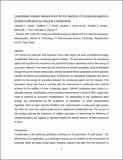| dc.contributor.author | Weber, Cameron C. | |
| dc.contributor.author | Wood, Geoffrey P. F. | |
| dc.contributor.author | Kunov-Kruse, Andreas J. | |
| dc.contributor.author | Nmagu, Douglas E. | |
| dc.contributor.author | Trout, Bernhardt L. | |
| dc.contributor.author | Myerson, Allan S. | |
| dc.date.accessioned | 2015-06-11T12:35:09Z | |
| dc.date.available | 2015-06-11T12:35:09Z | |
| dc.date.issued | 2014-06 | |
| dc.date.submitted | 2014-05 | |
| dc.identifier.issn | 1528-7483 | |
| dc.identifier.issn | 1528-7505 | |
| dc.identifier.uri | http://hdl.handle.net/1721.1/97382 | |
| dc.description.abstract | The removal of carboxylic acid impurities from amide targets has been accomplished through crystallization featuring a complexing agent in solution. The interaction between the complexing agents and impurities was examined using isothermal titration calorimetry and the free energy of association obtained. From these data, the mechanism of solution association could be elucidated through the use of infrared spectroscopy, density functional theory calculations, and the judicious variation of solvent and complexing agent. Furthermore, the calculations employed were able to predict the free energy of association between the complexing agents and the impurity. This association energy was found to correlate with the improvement in purification that could be achieved by the addition of these complexing agents. Optimal complexing agent choice in a rationally selected crystallization solvent produced improvements in purity of 96%, greater than could be achieved by successive crystallizations. The applicability of this complexing agent strategy was demonstrated for the purification of fenofibrate, an active pharmaceutical ingredient, from its major impurity fenofibric acid. Improvements in purity were again greater than 90%, far more than could be achieved by an additional crystallization step. The success of this strategy indicates the importance of solution association in determining the efficiency of complexing agents and suggests an approach toward the rational selection of these compounds in silico. | en_US |
| dc.description.sponsorship | Novartis (Firm) | en_US |
| dc.language.iso | en_US | |
| dc.publisher | American Chemical Society (ACS) | en_US |
| dc.relation.isversionof | http://dx.doi.org/10.1021/cg500709h | en_US |
| dc.rights | Article is made available in accordance with the publisher's policy and may be subject to US copyright law. Please refer to the publisher's site for terms of use. | en_US |
| dc.source | Prof. Trout via Erja Kajosalo | en_US |
| dc.title | Quantitative Solution Measurement for the Selection of Complexing Agents to Enable Purification by Impurity Complexation | en_US |
| dc.type | Article | en_US |
| dc.identifier.citation | Weber, Cameron C., Geoffrey P. F. Wood, Andreas J. Kunov-Kruse, Douglas E. Nmagu, Bernhardt L. Trout, and Allan S. Myerson. “Quantitative Solution Measurement for the Selection of Complexing Agents to Enable Purification by Impurity Complexation.” Crystal Growth & Design 14, no. 7 (July 2, 2014): 3649–3657. | en_US |
| dc.contributor.department | Novartis-MIT Center for Continuous Manufacturing | en_US |
| dc.contributor.department | Massachusetts Institute of Technology. Department of Chemical Engineering | en_US |
| dc.contributor.approver | Trout, Bernhardt L. | en_US |
| dc.contributor.mitauthor | Weber, Cameron C. | en_US |
| dc.contributor.mitauthor | Wood, Geoffrey P. F. | en_US |
| dc.contributor.mitauthor | Kunov-Kruse, Andreas J. | en_US |
| dc.contributor.mitauthor | Nmagu, Douglas E. | en_US |
| dc.contributor.mitauthor | Trout, Bernhardt L. | en_US |
| dc.contributor.mitauthor | Myerson, Allan S. | en_US |
| dc.relation.journal | Crystal Growth & Design | en_US |
| dc.eprint.version | Author's final manuscript | en_US |
| dc.type.uri | http://purl.org/eprint/type/JournalArticle | en_US |
| eprint.status | http://purl.org/eprint/status/PeerReviewed | en_US |
| dspace.orderedauthors | Weber, Cameron C.; Wood, Geoffrey P. F.; Kunov-Kruse, Andreas J.; Nmagu, Douglas E.; Trout, Bernhardt L.; Myerson, Allan S. | en_US |
| dc.identifier.orcid | https://orcid.org/0000-0003-1417-9470 | |
| mit.license | PUBLISHER_POLICY | en_US |
| mit.metadata.status | Complete | |
